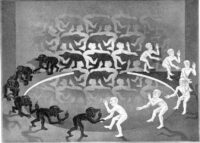When I was young, I used to love to take things apart and reassemble them into something else. Electric clocks were a particular favorite; I would remove the motors and gears and attach propellers or colored disks made from shirt cardboards, reattach the wires, install switches and set them all a’spinning. At one point, I had a bank of switches at the head of my bed, and could control whirling colors, flashing lights and squawking transistor radio speakers all over the room. What for me was childhood fun, in the adult world is serious stuff; the penchant to take things apart and play with the pieces is big business.
Genetic engineers identify single genes, determine how they express themselves in a living organism, and then derive products for marketing. The U.S. Patent Office awards patents on specifically identified and isolated single genes, despite their natural origins. These patents and the revenues from resulting pharmaceuticals can be highly profitable.
The food industry spends billions on taking food apart, isolating its separate constituents, determining the function or action of a specific constituent, and developing methods to modify or aggregate them in food products. Thus, grains are processed to facilitate manufacture, taste or texture, which strips away nutrients, and then the individual nutrients are reintegrated into the final product. Milk, cereals, and many other common foods are subject to an elaborate manufacturing process.
Physicists take things apart, also, and the largest high energy super-collider, a 23-mile-long ringed tunnel, is being built on the border of France and Switzerland. This machine will accelerate sub-atomic particles to extraordinary speeds and crash them into each other. These collisions will break apart these smallest pieces of matter into yet smaller pieces, and physicists will identify ever smaller bits and pieces.
These activities embody reductionist philosophy, the notion that the meaning of things can be found by reducing them to their smallest possible constituents. Such reduction implies an ever-increasing sense of “purity” as the “extraneous” parts are identified and discarded. At some point, it is supposed, we get down to the final, irreducible meaningful underlying factor.
The problem with reductionist philosophy, however, is that our universe manifests both separation and unity, and unity cannot be discounted in discerning meaning. Recently, a consortium of researchers from many countries determined that one individual gene interacts with other genes in its full expression; its function cannot be fully defined in isolation. All those gene patents may have to be withdrawn. Author Michael Pollan, in an article in the New York Times Magazine, pointed out that isolating nutrients in food from the other compounds and constituents with which they naturally occur renders many nutrients useless in the human body. So much for “nutrient-fortified.” As physicists narrow in on the absolutely smallest particles they can find, they find themselves literally finding nothing. At the heart of all things may be a small vibrating “string” of one dimension, a billionth of a billionth of a billionth of a centimeter in length.
Taking things apart and reducing them to their components is an interesting thing to do; it may even provide profound insights into the nature of existence. Ultimately, however, our greater understanding will come from learning how individual pieces work together.
We welcome your feedback. For general feedback or to contact one of our columnists, please visit the Columns page at www.sonomasun.com.
Deconstructing reductionist philosophy
More from Public CitizenMore posts in Public Citizen »




